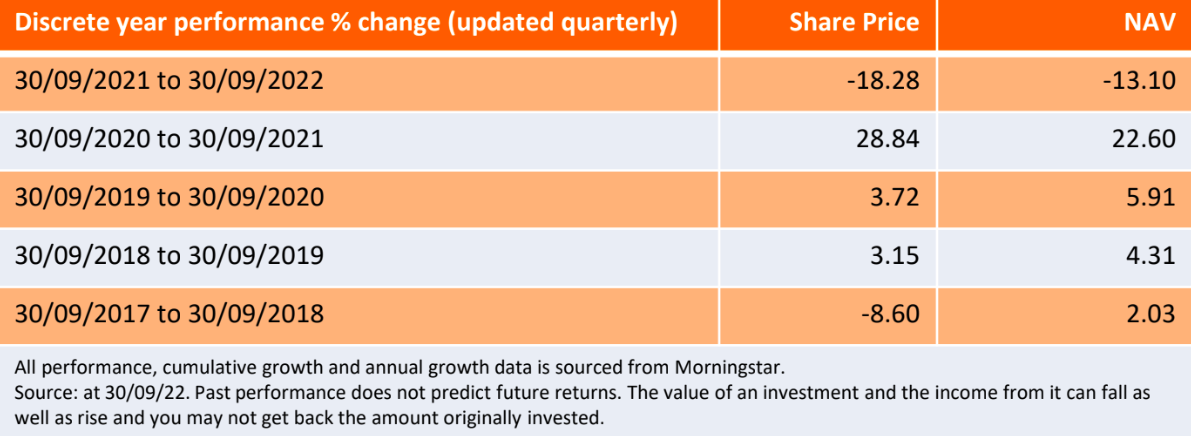
Investment environment
European equity indices delivered another mid-single digit decline in September, having started the month with a guarded rally which ultimately peaked on the 12th of the month. Commentary from central bankers reinforced the message that real economic pain will need to be firmly in evidence before the US Federal Reserve (Fed) -and by extension other major monetary institutions -even considers a pause, let alone a ‘pivot’, in the tightening of financial conditions. In its quest to suppress inflation at all costs, it appears the Fed is no longer the friend that equity markets have been conditioned to believe since the Global Financial Crisis. As such, “bad” data will be required to bring about the oxygen of monetary relief and, so far, this has not materialised in key inflation and labour market indicators (even if they are backward looking).
The new UK leadership offered up a valuable lesson to any other nations thinking of throwing fiscal caution to the wind: do not pick a fight with the bond market, ever, especially not now. The value of sterling dived, gilt yields spiked, and the Bank of England (BoE) had to step in with a dose of mini-quantitative easing to prevent a systemic financial accident. We are cognisant of the risk of a repeat elsewhere given the UK episode was, at its heart, a function of globally tighter financial conditions and US dollar strength. Italy is an obvious candidate to potentially cause such an accident due to i) high debt levels and fractured domestic politics, and ii) its monetary master, the European Central Bank (ECB), having to achieve the somewhat counterintuitive dual feat of raising the price of money for everyone, everywhere within Europe, except for the Italian government. We would not construct a portfolio on the basis of such a binary macroeconomic outcome, but it is fair to say we consider it high up on the list of possible risks.
Portfolio review
Adverse news flow on two specific stocks, Kion and Mowi, accounted for the majority of our underperformance over the period. Kion has encountered significant execution problems in its warehouse automation business as underlying projects had not been protected adequately against cost inflation. Mowi has been hit by an unexpected resource tax in Norway which has increased the tax charge on the local salmon farming industry from 22% to 62%. While this announcement by the Norwegian government has triggered contentious debates and its ultimate implementation is not 100% given, the damage to the investment profile of this otherwise compelling sector is now in doubt. As such, we have reduced our holding. We also had disappointing returns from Grifols, plasma derived drugs firm. While Grifols’ fundamental development has actually been improving, the market has increasingly focused on the high financial leverage of the company, fuelling speculation around a possible equity raise.
Disaster scenarios aside, we believe Europe has already largely priced in a ‘normal’ recession and therefore we have been selectively adding to names in which we believe the lows have likely been reached. These names include Atlas Copco, Arkema and new purchases in the semi-conductor space: ASM International and STMicroelectronics. We reduced a portion of our energy sector overweight -which is still substantial -to fund an increase in exposure to banks. We remain underweight banks (a common theme for us) but are sensitive to the potential mitigation of delinquency risk through direct government support for utility bills. Combined with rising net interest income (a function of higher interest rates), the outlook for bank earnings may therefore be less bad. Moreover, if an unlikely Ukrainian ceasefire were to be called, our energy overweight position could hurt us while banks could offer a partial hedge in our view. We bought European names Commerzbank and ING and disposed of Bayer as our conviction waned.
Manager Outlook
High inflation is eroding household budgets, leading to a decline in consumer sentiment and static or declining retail sales.The continent as a whole faces energy uncertainty in the near term, brought on by the conflict of Russia’s invasion of Ukraine. While we would not construct a portfolio on the basis of such binary macroeconomic outcomes, we continue to add value to the portfolio at sector theme and stock selection levels.

Gilt yields – Gilt yields express the return on a gilt (government bond) as an annual percentage
Inflation – The rate at which the prices of goods and services are rising in an economy. The CPI and RPI are two common measures. The opposite of deflation.
Leverage – The use of borrowing to increase exposure to an asset/market. This can be done by borrowing cash and using it to buy an asset, or by using financial instruments such as derivatives to simulate the effect of borrowing for further investment in assets
Recession – A recession is a significant, widespread, and prolonged downturn in economic activity. Because recessions often last six months or more, one popular rule of thumb is that two consecutive quarters of decline in a country’s Gross Domestic Product (GDP) constitute a recession.
Valuation metrics – Metrics used to gauge a company’s performance, financial health, and expectations for future earnings e.g., price to earnings (P/E) ratio and return on equity (ROE).
Quantitative easing – An unconventional monetary policy used by central banks to stimulate the economy by boosting the amount of overall money in the banking system.